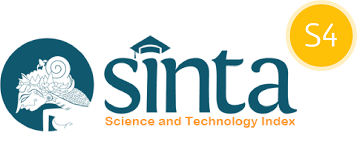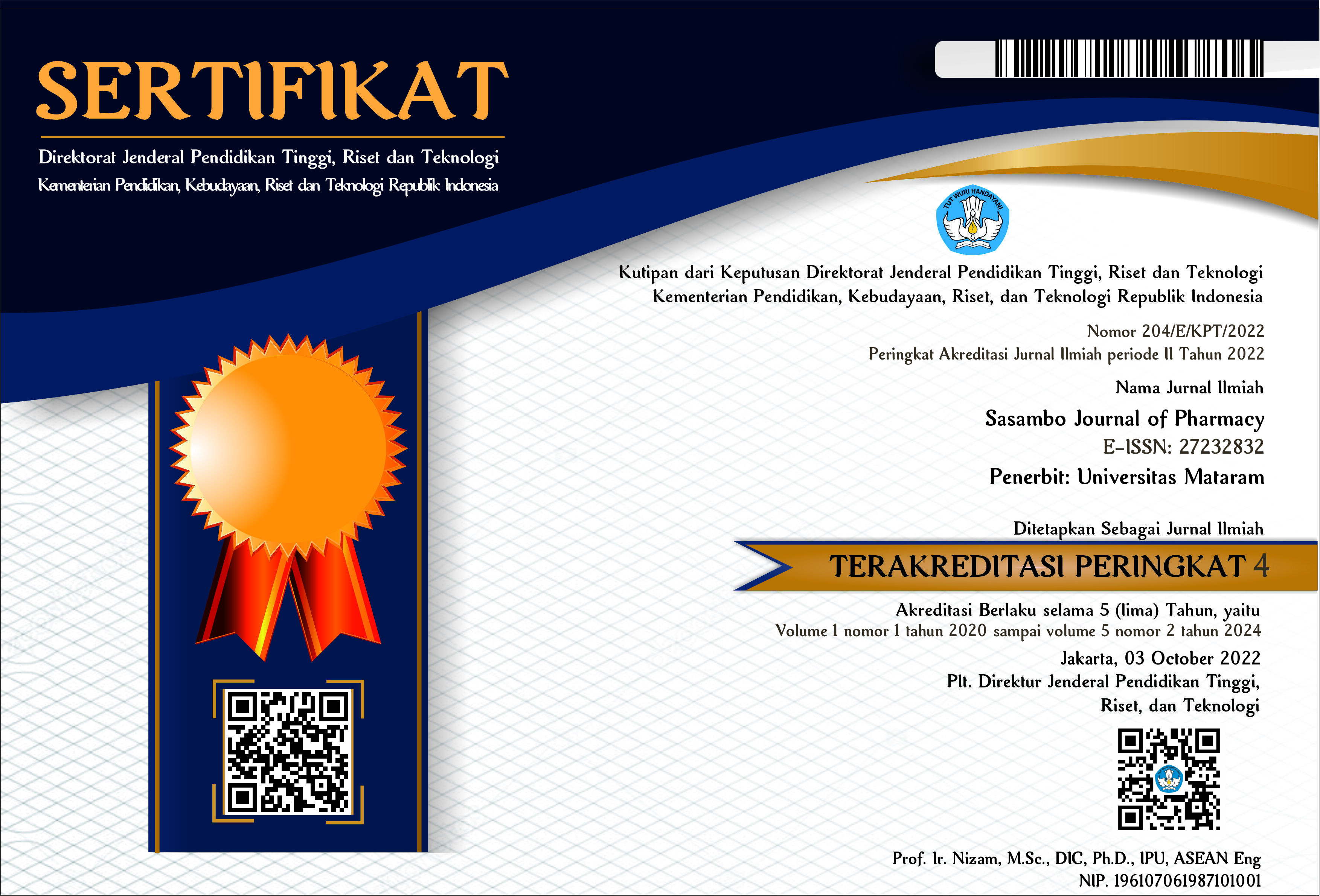Potensi anti-kanker payudara tanaman songga (Strychnos lucida R.Br): Tinjauan interaksi molekuler terhadap reseptor estrogen-α in silico
DOI:
10.29303/sjp.v3i1.149Downloads
Abstract
Songga (Styrchnos lucida R.Br) is a plant that has potential to be developed as an anti-breast cancer against. This study was conducted to predict the secondary metabolite derived from songga, which potential as anti-breast cancer through inhibition of estrogen receptor-α. A molecular docking study was carried out using Autodock Vina assisted by AutodockTool and Biovia Discovery Studio. The study used estrogen receptor-α as a protein and ten compounds from songga as ligands. The 3D structure of estrogen receptor-α and ten ligands were obtained from Protein Data Bank and the PubChem database. The result revealed that strychnine N-oxide is the compound that has the lowest free binding energy and inhibition constant with the value 9.6 kcal/mol and 0.09 µM, respectively. This indicated that strychnine N-oxide has an excellent affinity for estrogen receptor-α. Thus, this compound is predicted to inhibit the estrogen receptor-α and can be developed as anti-breast cancer. However, further investigations such as molecular dynamics simulation, in vitro and in vivo assays should be undertaken.
Keywords:
Songga, Strychnos lucida, breast cancer, estrogen receptor-αReferences
Afriza, D., Suriyah, W. H., & Ichwan, S. J. A. (2018). In silico analysis of molecular interactions between the anti-apoptotic protein survivin and dentatin, nordentatin, and quercetin. Journal of Physics: Conference Series, 1073(3). https://doi.org/10.1088/1742-6596/1073/3/032001
Bai, Z., & Gust, R. (2009). Breast cancer, estrogen receptor and ligands. Archiv Der Pharmazie, 342(3), 133–149. https://doi.org/10.1002/ardp.200800174
Brooks, B. R., Brooks, C. L. 3rd, Mackerell, A. D. J., Nilsson, L., Petrella, R. J., Roux, B., Won, Y., Archontis, G., Bartels, C., Boresch, S., Caflisch, A., Caves, L., Cui, Q., Dinner, A. R., Feig, M., Fischer, S., Gao, J., Hodoscek, M., Im, W., … Karplus, M. (2009). CHARMM: the biomolecular simulation program. Journal of Computational Chemistry, 30(10), 1545–1614. https://doi.org/10.1002/jcc.21287
Busonero, C., Leone, S., & Acconcia, F. (2017). Emetine induces estrogen receptor alpha degradation and prevents 17β-estradiol-induced breast cancer cell proliferation. In Cellular oncology (Dordrecht) (Vol. 40, Issue 3, pp. 299–301). https://doi.org/10.1007/s13402-017-0322-z
Cazzaniga, M., & Bonanni, B. (2012). Breast cancer chemoprevention: old and new approaches. Journal of Biomedicine & Biotechnology, 2012, 985620. https://doi.org/10.1155/2012/985620
Ciruelos, E., Pascual, T., Arroyo Vozmediano, M. L., Blanco, M., Manso, L., Parrilla, L., Muñoz, C., Vega, E., Calderón, M. J., Sancho, B., & Cortes-Funes, H. (2014). The therapeutic role of fulvestrant in the management of patients with hormone receptor-positive breast cancer. Breast (Edinburgh, Scotland), 23(3), 201–208. https://doi.org/10.1016/j.breast.2014.01.016
Eroles, P., Bosch, A., Pérez-Fidalgo, J. A., & Lluch, A. (2012). Molecular biology in breast cancer: intrinsic subtypes and signaling pathways. Cancer Treatment Reviews, 38(6), 698–707. https://doi.org/10.1016/j.ctrv.2011.11.005
Itoh, A., Tanaka, Æ. Y., & Nagakura, Æ. N. (2006). A quinic acid ester from Strychnos lucida. 146–148. https://doi.org/10.1007/s11418-005-0021-3
Jemal, A., Bray, F., & Ferlay, J. (2011). Global Cancer Statistics: 2011. CA Cancer J Clin, 49(2), 1,33-64. https://doi.org/10.3322/caac.20107.Available
Ko, E.-Y., & Moon, A. (2015). Natural Products for Chemoprevention of Breast Cancer. Journal of Cancer Prevention, 20(4), 223–231. https://doi.org/10.15430/JCP.2015.20.4.223
Leon-Ferre, R. A., Polley, M.-Y., Liu, H., Gilbert, J. A., Cafourek, V., Hillman, D. W., Elkhanany, A., Akinhanmi, M., Lilyquist, J., Thomas, A., Negron, V., Boughey, J. C., Liu, M. C., Ingle, J. N., Kalari, K. R., Couch, F. J., Visscher, D. W., & Goetz, M. P. (2018). Impact of histopathology, tumor-infiltrating lymphocytes, and adjuvant chemotherapy on prognosis of triple-negative breast cancer. Breast Cancer Research and Treatment, 167(1), 89–99. https://doi.org/10.1007/s10549-017-4499-7
Lipinski, C. A. (2004). Lead- and drug-like compounds: the rule-of-five revolution. Drug Discovery Today: Technologies, 1(4), 337–341 https://doi.org/https://doi.org/10.1016/j.ddtec.2004.11.007
Manurung, H., Sari, R. K., Syafii, W., Cahyaningsih, U., & Ekasari, W. (2019). Antimalarial activity and phytochemical profile of ethanolic and aqueous extracts of bidara laut (Strychnos ligustrina Blum) wood. Journal of the Korean Wood Science and Technology, 47(5), 587–596. https://doi.org/10.5658/WOOD.2019.47.5.587
Matsuo, K., Shimada, M., Yamaguchi, S., Kanao, H., Nakanishi, T., Saito, T., Kamiura, S., Iwata, T., Mikami, M., & Sugiyama, T. (2018). Identifying a candidate population for ovarian conservation in young women with clinical stage IB–IIB cervical cancer. International Journal of Cancer, 142(5), 1022–1032. https://doi.org/10.1002/ijc.31084
Morris, G. M., Huey, R., Lindstrom, W., Sanner, M. F., Belew, R. K., Goodsell, D. S., & Olson, A. J. (2009). AutoDock4 and AutoDockTools4: Automated docking with selective receptor flexibility. Journal of Computational Chemistry, 30(16), 2785–2791. https://doi.org/10.1002/jcc.21256
Muttaqin, F. Z., Kharisma, D., Asnawi, A., & Kurniawan, F. (2020). Pharmacophore and Molecular Docking-Based Virtual Screening of B-Cell Lymphoma 2 (BCL 2) Inhibitor from Zinc Natural Database as Anti-Small Cell Lung Cancer. 10(2), 143–147.
Paterni, I., Granchi, C., Katzenellenbogen, J. A., & Minutolo, F. (2014). Estrogen receptors alpha (ERα) and beta (ERβ): subtype-selective ligands and clinical potential. Steroids, 90, 13–29. https://doi.org/10.1016/j.steroids.2014.06.012
Russo, J., & Russo, I. H. (2006). The role of estrogen in the initiation of breast cancer. Journal of Steroid Biochemistry and Molecular Biology, 102(1-5 SPEC. ISS.), 89–96. https://doi.org/10.1016/j.jsbmb.2006.09.004
Sarmento, N. da C., Worachartcheewan, A., Pingaew, R., Prachayasittikul, S., Ruchirawat, S., & Prachayasittikul, V. (2015). Antimicrobial, antioxidant and anticancer activities of Strychnos lucida R. Br. African Journal of Traditional, Complementary and Alternative Medicines, 12(4), 122–127. https://doi.org/10.4314/ajtcam.v12i4.18
Setiawan, O., & Rostiwati, T. (2014). Bidara Laut (Strychnos ligustrina Blume. syn. S. lucida R. Br): HHBK Potensial di NTB dan Bali. In Bogor: Forda Press.
Trott, O. & Olson, A.J. (2010). AutoDock Vina: improving the speed and accuracy of docking with a new scoring function, efficient optimization and multithreading, Journal of Computational Chemistry 31, 455-461.
Waks, A. G., & Winer, E. P. (2019). Breast Cancer Treatment: A Review. JAMA, 321(3), 288–300. https://doi.org/10.1001/jama.2018.19323
License
Copyright (c) 2022 The Author(s)

This work is licensed under a Creative Commons Attribution 4.0 International License.
Authors who publish with Sasambo Journal of Pharmacy (SJP), agree to the following terms:
- Authors retain copyright and grant the journal right of first publication with the work simultaneously licensed under a Lisensi Creative Commons Atribusi 4.0 Internasional. This license allows authors to use all articles, data sets, graphics and appendices in data mining applications, search engines, web sites, blogs, and other platforms by providing an appropriate reference. The journal allows the author(s) to hold the copyright without restrictions and will retain publishing rights without restrictions.
- Authors are able to enter into separate, additional contractual arrangements for the non-exclusive distribution of the journal's published version of the work (e.g., post it to an institutional repository or publish it in a book), with an acknowledgment of its initial publication in Sasambo Journal of Pharmacy
- Authors are permitted and encouraged to post their work online (e.g., in institutional repositories or on their website) prior to and during the submission process, as it can lead to productive exchanges, as well as earlier and greater citation of published work (See The Effect of Open Access).







